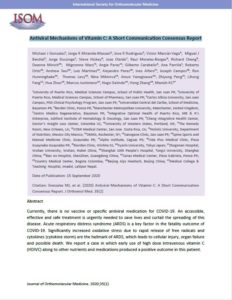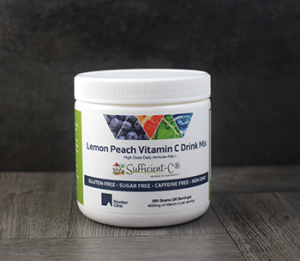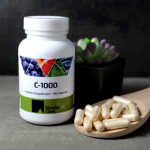Antiviral Mechanisms of Vitamin C: A Short Communication Consensus Report
 Authors
Authors
Michael J Gonzalez¹; Jorge R Miranda-Massari²; Jose R Rodriguez³; Victor Marcial-Vega⁴; Miguel J Berdiel⁵; Jorge Duconge²; Steve Hickey⁶; Jose Olalde⁷; Raul Morales-Borges⁸; Richard Cheng⁹; Deanna Minich¹⁰; Mignonne Mary¹¹; Angie Perez¹²; Gilberto Caraballo⁸; Ana Parrilla¹; Roberto Ortiz¹³; Andrew Saul¹⁴; Luis Martinez¹⁵; Alejandro Perez¹⁶; Ines Alfaro¹⁷; Joseph Campos¹⁸; Ron Hunninghake¹⁹; Thomas Levy¹⁹; Nina Mikirova¹⁹; Atsuo Yanagisawa²⁰; Zhiyong Peng²¹; Lihong Fang²²; Hua Zhou²³; Marcos Justiniano²⁴; Hugo Galindo²⁵; Hong Zhang²⁶; Manish KC²⁷
Date of Publication
September 15, 2020
International Society for Orthomolecular Medicine
Abstract
Currently, there is no vaccine or specific antiviral medication for COVID-19. An accessible, effective and safe treatment is urgently needed to save lives and curtail the spreading of this disease. Acute respiratory distress syndrome (ARDS) is a key factor in the fatality outcome of COVID-19. Significantly increased oxidative stress due to rapid release of free radicals and cytokines (cytokine storm) are the hallmark of ARDS, which leads to cellular injury, organ failure and possible death. We report a case in which early use of high dose intravenous vitamin C (HDIVC) along to other nutrients and medications produced a positive outcome in this patient.
Introduction
Vitamin C is an essential micronutrient for humans, with an array of pleiotropic physiological functions related to its ability to donate electrons. It is a cofactor for numerous biosynthetic and gene regulatory enzymes (Carr & Maggini, 2017). Due to its strong reducing potential, Vitamin C is involved in numerous metabolic processes. Vitamin C contributes to the immune system by supporting various cellular functions of both the innate and adaptive immune system.
The immune system is a multifaceted and sophisticated network that protects the host from a range of pathogens, such as bacteria, fungi, parasites, cancer cells and viruses. The immune system can be characterized as innate and adaptive. The innate immune system is composed of physical and chemical barriers as well as cells such as phagocytic leukocytes, dendritic cells, natural killer cells, and plasma proteins. The adaptive immune system (also referred as the acquired immune system) has two types of adaptive responses: the cell-mediated immune response, which is carried out by T cells, and the humoral immune response, which is controlled by activated B cells and antibodies.
A major symptom of the Vitamin C deficiency disease scurvy is an enhanced susceptibility to infections, particularly of the respiratory tract, with pneumonia being one of the most frequent complications of scurvy and a major cause of death. Administration of vitamin C to patients with acute respiratory infections returns their plasma vitamin C levels to normal and ameliorates the severity of the respiratory symptoms (Hunt et al. 1994; Marik, 2018; Marik, 2018; Fowler et al. 2017).
Cases of acute lung infections have shown rapid clearance on chest X-rays following administration of intravenous Vitamin C (Bharara, 2016; Fowler et al. 2017). This vitamin C-dependent clearance of neutrophils from infected lungs could conceivably be due to enhanced apoptosis and subsequent phagocytosis and clearance of the spent neutrophils by macrophages (Vissers & Wilke, 2017).
Vitamin C has demonstrated potent antiviral activity when utilized in large doses either in strategically taken oral doses or by intravenous route (Colunga Biancatelli et al. 2020). Clinical evidence exists that shows vitamin C’s potent antiviral effect. Studies in which very large amounts of vitamin C have been used to treat different viral infections have been published (Gonzalez et al. 2014; Marcial-Vega et al. 2017; Gonzalez et al. 2016; Gonzalez et al. 2018a; Gonzalez et al. 2018b). Frequent oral doses with vitamin C sufficient to reach a bowel tolerance limit will work as antiviral therapy for most people (Cathcart, 1981). Intravenous vitamin C is indicated for the most serious cases.
It is our experience, as well as others, that the sicker a person was, the more ascorbic acid they would tolerate orally without it causing diarrhea. A healthy person with a normal GI tract may tolerate 5 to 15 grams of ascorbic acid taken orally without diarrhea. A person with a mild cold may tolerate 30 to 60 grams; with a bad cold about 75 grams; with influenza close to 100 grams. With mononucleosis, viral pneumonia, etc. 150- 200 grams or more of ascorbic acid would be tolerated orally without diarrhea (Cathcart, 1981). The method to determine proper dose (the dose that will eliminate acute symptoms without causing diarreha), by titrating to bowel tolerence was first described by Cathcart. Symptoms are usually neutralized when a dose of about 90% or more of bowel tolerance is reached with oral ascorbic acid.
Another interesting concept is Hickey’s dynamic flow model (Hickey et al. 2005). In the dynamic flow model, an excess of oral ascorbate provides a steady flow of electrons through the body. The dynamic flow model proposes restoring human physiology to approximate that of animals that synthesize their own vitamin C. This can be achieved by consuming excess ascorbate, over and above the amount normally absorbed. This intake is spread throughout the day, so a consistent supply is achieved. Vitamin C is transported across cellular membranes by the sodium-dependent vitamin C transporter (SVCT) and by glucose transporters (GLUT). Glucose transporters are a wide group of membrane proteins that facilitate the transport of glucose across the plasma membrane. The sicker you are the more active these transporters are.
Vitamin C as a metabolic modulator
Sepsis is characterized by systemic inflammation, increased oxidative stress, insulin resistance, and peripheral hypoxia. Sepsis is a life-threatening systemic inflammatory response that can result in multi-organ dysfunction. Sepsis represents a medical condition in which the presence of vitamin C and other antioxidants have been severely depleted. Immune effector cells depend on glycolysis as their source of energy, lung epithelial cells use mitochondrial oxidative phosphorylation to produce their energy. High-dose vitamin C treatment acts as both a pro-oxidant for immune cells, and an antioxidant for lung epithelial cells (Erol, 2020). The pro-oxidant role of vitamin C requires pharmacological (millimolar) rather than physiological (micromolar) concentrations. However, a concern that may arise with high-dose vitamin C treatment of pneumonia is that it produces an osmotic cell death of immune cells, rather than apoptosis, which could generate a local inflammation in the alveoli. Therefore, IV glucocorticoid treatment must be added to attenuate the possible inflammatory complications of high-dose vitamin C treatment. For the purpose of this article, we will define high-dose intravenous vitamin C treatment as infusion(s) of at least 5 g a day. It should be considered to add hydrocortisone 50 mg IV every 6 hours for 7 days to fight against vitamin C therapy-induced inflammation. Although we must mention that endogenous cortisol levels in sepsis are already very high, this activity occurs in an attempt to compensate for the oxidation of the cortisol receptors. vitamin C may reduce the oxidation of the receptors permitting endogenous cortisol to kick in. Vitamin C, when used as a parenteral agent in high doses, may act pleiotropically as a pro-oxidant to attenuate pro-inflammatory mediator expression (Lee et al. 2020; Mikirova & Scimeca, 2016), improve alveolar fluid clearance, and at the same time, may act as an antioxidant to improve epithelial lung cell functions (Rodrigues et al. 2018; Das et al. 2018). At high-dose, vitamin C acts as a pro-oxidant or antioxidant in a cell-type dependent (environmentally determined) manner (Erol, 2020; Lee et al. 2020; Mikirova & Scimeca, 2016; Rodrigues et al. 2018; Das et al. 2018; Yun et al. 2015; Ngo et al. 2019). This presents vitamin C as a multifunctional, multifaceted versatile metabolic modulator.
Antiviral Mechanisms of Ascorbic Acid
Direct mechanisms:
Damage of the viral capsid due to ascorbic acid redox capacity when given in pharmacological doses. Ascorbic acid is a powerful reducing agent (Cheng et al. 2012; Furuya et al. 2008).
Disruption of viral capsid sugar moiety of its glycoprotein envelope when given in pharmacological doses (Asim et al. US20130004458A).
Inhibition of viral replication when provided in pharmacological doses by creating a hostile environment for this activity to occur, in addition to directly inhibiting viral replication enzymes (Colunga Biancatelli et al. 2020; Kim et al. 2013; Jariwalla & Harakeh, 1996). Ascorbic acid causes degradation of single and double-stranded genomes of RNA and DNA viruses (Murata & Kitagawa, 1973; Murata & Uike, 1976; Wong et al. 1974) so that replication becomes susceptible to ascorbate-mediated damage, resulting in reduced viral protein production.
Indirect mechanisms:
Increases cellular immunity through increasing the number, activity, and aggressiveness of immune cells such as leukocytes, lymphocytes, NK cells, macrophages. Lymphocyte function and production are influenced by vitamin C concentrations (Sorice et al. 2014). Vitamin C accumulates in the lysosomes of phagocytic cells and enhances chemotaxis, chemokinesis and phagocytosis. Vitamin C in the presence of oxygen favors the generation of reactive oxygen species such as H2O2 (Frei & Lawson, 2008). Vitamin C has been shown to increase mobility and chemotaxis of phagocytes (Murata & Uike, 1976). White blood cells accumulate vitamin C against a concentration gradient, resulting in values that are 50- to 100-fold higher than plasma concentrations (Goldschmidt, 1991; Bergsten et al. 1990; Evans et al. 1982).
Increases humoral immunity through the production of antibodies (Carr & Maggini, 2017; Tanaka et al. 1994; Feigen et al. 1982).
Increases anti-viral proteins such as α/β interferons while downregulating the production of pro-inflammatory cytokines TNF-α and IL-6 (Colunga Biancatelli et al. 2020; Wintergerst et al. 2006; Dahl & Degre, 1976).
Increases energy by providing necessary electrons and electron movement that increases mitochondrial electron flux for ATP generation (Gonzalez et al. 2005, Gonzalez et al. 2010).
Limits glucose utilization as the main source of energy pathogenic organisms, when provided in pharmacological doses (Dakhale et al. 2011, Sanchez 2015; Ripoli et al. 2010). DNA and RNA viruses are able to induce glycolysis. Viruses are able decrease host cell oxidative phosphorylation and increases dependence on extracellular glucose.
Antioxidant action is elicited when vitamin C is provided in proper doses to prevent the dangerous and severe pathological cascade of the cytokine storm (Carr & Maggini, 2017; Marik 2018a; Marik 2018b; Hickey et al. 2005; Marik, 2016). Mitigates the cytokine storm – cytokines can elicit pro-inflammatory or anti-inflammatory responses, and Vitamin C appears to modulate systemic and leukocyte-derived cytokines. Vitamin C protects the host cells against the oxidants released by phagocytes. Vitamin C decreases the generation of the pro-inflammatory cytokines TNF-α and IL-6 (Chen et al. 2014).
The lethal pathology underlying COVID-19 is acute lung injury (ALI)/acute respiratory syndrome (ARDS) induced by cytokine storm or significantly elevated oxidative stress. These pathologies were also found in SARS and MERS and other respiratory viral infections, as well as viruses affecting other parts of the body causing multi-organ failure. The clinical observations of vitamin C in ameliorating pneumonia, ARDS and sepsis support vitamin C’s antioxidant, anti-viral, and immune-boosting effects.
Maintains structural integrity of cells via the promotion of collagen formation (Englard & Seifter, 1986; Murad et al. 1981). Vitamin C protects endothelial barrier function against the insult of sepsis (Han et al. 2010).
Modulates gene expression. Vitamin C administration decreases expression of susceptibility genes, including mitochondrial antiviral signaling (MAVS) and interferon regulatory factor 3 (IRF3), and increased expression of NF-κB. These in conjunction induce type I interferons (IFNs) and elicit innate antiviral response (Cai et al. 2015).
Vitamin C is capable of combating all types of viruses when given in high doses, but even at a low supplemental amount, it is helpful. This is very important for those with low incomes and few treatment options. For example, in one well-controlled, randomized study, just 200 mg/day of vitamin C given to the elderly resulted in improvement in respiratory symptoms in the most severely ill, hospitalized patients; in addition, there were 80% fewer deaths in the vitamin C group (Hunt et al. 1994)
The SARS-coV-2 (coronavirus), as an acute infection, should be expected to be just as susceptible to vitamin C as all the other viruses against which it has been proven to be very effective. There has never been a documented situation in which sufficient high dosages of vitamin C have been unable to neutralize any virus against which it has been tested (Klenner, 1951).
Many physicians consider high doses of Vitamin C to be so powerful an anti-viral agent that it may be ranked as a functional immunization for a variety influenza strains (Saul, 2005).
Conclusion
Vitamin C can be used as a stand-alone therapeutic agent to eradicate a viral/bacterial infection if given in high doses as constant infusions (Zabet et al. 2016). Based on this mechanistic rationale explaining the therapeutic use of vitamin C to prevent inflammatory hyperactivation in myeloid and lymphoid cells we conclude that supplementation with high dose vitamin C appears to be able to both prevent and help treat respiratory and systemic infections. Ascorbate at sufficiently high doses can prevent viral disease and greatly speed recovery from an acute viral infection.
Acknowledgements
The authors would like to thank Ms. Eliza Llenza for her help in the preparation of this manuscript.
References
Asim DK, Zhang H, Curreli F. Small Molecule Inhibitors of Retroviral Assembly and Maturation. US20130004458A United States patent.
Bergsten P, Amitai G, Kehrl J, Dhariwal KR, Klein HG, Levine M (1990) Millimolar concentrations of ascorbic acid in purified human mononuclear leukocytes. Depletion and re-accumulation. J Biol Chem. 265: 2584–2587.
Bharara A, Grossman C, Grinnan D, Syed AA, Fisher BJ, DeWilde C, Natarajan R, Fowler AA (2016) Intravenous Vitamin C administered as adjunctive therapy for recurrent acute respiratory distress syndrome. Case Rep Crit Care. 2016:8560871. https://doi.org/10.1155/2016/8560871
Cai Y, Li YF, Tang LP, Tsoi B, Chen M, Chen H, Chen XM, Tan RR, Kurihara H, He RR (2015). A new mechanism of vitamin C effects on A/FM/1/47(H1N1) virus-induced pneumonia in restraint-stressed mice. Biomed Res Int. 2015:675149. https://doi.org/10.1155/2015/675149
Carr AC, Maggini S (2017) Vitamin C and immune function. Nutrients. 9(11):1211. https://doi.org/10.3390/nu9111211
Cathcart RF (1981) The method of determining proper doses of Vitamin C for the treatment of disease by titrating to bowel tolerance. Orthomolec Psychiat. 10(2):125-132.
Chen Y, Luo G, Yuan J, Wang Y, Yang X, Wang X, Li G, Liu Z, Zhong N (2014). Vitamin C mitigates oxidative stress and tumor necrosis factor-alpha in severe community-acquired pneumonia and LPS-induced macrophages. Mediators Inflamm. 2014: 426740. https://doi.org/10.1155/2014/426740
Cheng LL, Liu YY, Li B, Ran PX (2012) An in vitro study on the pharmacological ascorbate treatment of influenza virus. Zhonghua Jie He He Hu Xi Za Zhi. 35(7):520–23. https://doi.org/10.3760/cma.j.issn.1001-0939.2012.07.010
Colunga Biancatelli RML, Berrill M, Marik, PE (2020) The antiviral properties of Vitamin C. Expert Rev Anti Infect Ther. 18(2):99-101. https://doi.org/10.1080/14787210.2020.1706483
Dahl H, Degré M (1976). The effect of ascorbic acid on production of human interferon and the antiviral activity in vitro. Acta Pathol Microbiol Scand; Section B Microbiology. 84B(5): 280-284. https://doi.org/10.1111/j.1699-0463.1976.tb01938.x
Dakhale GN, Chaudhari HV, Shrivastava M (2011). Supplementation of vitamin C reduces blood glucose and improves glycosylated hemoglobin in type 2 diabetes mellitus: a randomized, double-blind study. Adv Pharmacol Sci. 2011:195271. https://doi.org/10.1155/2011/195271
Das JK, Bilal H, Salam RA, Bhutta ZA (2018) Vitamin C supplementation for prevention and treatment of pneumonia. Cochrane Database of Systematic Reviews. 9:CD013134. https://doi.org/10.1002/14651858.CD013134
Englard S, Seifter S (1986) The biochemical functions of ascorbic acid. Ann Rev Nut. 6: 365–406. https://doi.org/10.1146/annurev.nu.06.070186.002053
Erol A (2020) High-dose intravenous Vitamin C treatment for COVID-19 (a mechanistic approach). Preprint. https://doi.org/10.31219/osf.io/p7ex8
Evans RM, Currie L, Campbell A (1982) The distribution of ascorbic acid between various cellular components of blood, in normal individuals, and its relation to the plasma concentration. Br J Nutr. 47(3): 473–482. https://doi.org/10.1079/BJN19820059
Feigen G, Smith B, Dix C, Flynn CJ, Peterson NS, Rosenberg LT, Pavlović S, Leibovitz B (1982). Enhancement of antibody production and protection against systemic anaphylaxis by large doses of vitamin C. Res Comm Chem Pathol Pharmacol. 38(2):313-333.
Fowler AA, Kim C, Lepler L, Malhotra R, Debesa O, Natarajan R, Fisher BJ, Syed A, DeWilde C, Priday, A, Kasirajan V (2017) Intravenous Vitamin C as adjunctive therapy for enterovirus/rhinovirus induced acute respiratory distress syndrome. World J Crit Care Med. 6:85–90. http://dx.doi.org/10.5492/wjccm.v6.i1.85
Frei B, Lawson S (2008). Vitamin C and cancer revisited. Proc Natl Acad Sci U S A. 105(32):11037-11038. https://doi.org/10.1073/pnas.0806433105
Furuya A, Uozaki M, Yamasaki H, Arakawa T, Arita M, Koyama AH (2008) Antiviral effects of ascorbic acid and dehydroascorbic acids in vitro. Int J Mol Med. 22:541–545. https://doi.org/10.3892/ijmm_00000053
Goldschmidt MC (1991) Reduced bactericidal activity in neutrophils from scorbutic animals and the effect of ascorbic acid on these target bacteria in vivo and in vitro. Am J Clin Nutr. 54(6): 1214S–1220S. https://doi.org/10.1093/ajcn/54.6.1214s
Gonzalez MJ, Miranda-Massari JR, Riordan HD (2005). Vitamin C as an ergogenic aid. J Orthomol Med. 20(2):100-102.
Gonzalez MJ, Rosario-Pérez G, Guzmán AM, Miranda-Massari JR, Duconge J, Lavergne J, Fernandez N, Ortiz N, Quintero A, Mikirova N, Riordan NH and Ricart CM (2010). Mitochondria, Energy and Cancer: The Relationship with Ascorbic Acid. J Orthomol Med. 25(1): 29–38.
Gonzalez MJ, Miranda-Massari JR, Berdiel MJ, Duconge J, Rodríguez-López JL, Hunninghake R, Cobas-Rosario VJ (2014) High dose intravenous Vitamin C and Chikungunya fever: A case report. J Orthomol Med. 29(4):154- 156.
Gonzalez MJ, Berdiel MJ, Miranda-Massari JR, Duconge J, Rodríguez-López JL, Adrover-López PA (2016) High dose intravenous Vitamin C treatment for Zika fever. J Orthomol Med. 31(1):19-22.
Gonzalez MJ, Berdiel MJ, Duconge J, Levy TE, Alfaro IM, Morales-Borges R, Marcial-Vega V, Olalde, J (2018a) High dose intravenous Vitamin C and influenza: A case report. J Orthomol Med. 33(3):1-3.
Gonzalez MJ, Berdiel MJ, Olalde J (2018b) Intravenous Vitamin C and infectious mononucleosis: A case report. J Orthomol Med. 33(5):1-3.
Han M, Pandem S, Teh SL, Sukumaran DK, Wu F, Wilson JX (2010). Ascorbate protects endothelial barrier function during septic insult: Role of protein phosphatase type 2A. Free Radic Biol Med. 48(1):128-135. https://doi.org/10.1016/j.freeradbiomed.2009.10.034
Hickey DS, Roberts HJ, Cathcart RF (2005) Dynamic flow: A new model for ascorbate. J Orthomol Med. 20(4):237-244.
Hunt C, Chakravorty NK, Annan G, Habibzadeh N, Schorah, CJ (1994) The clinical effects of Vitamin C supplementation in elderly hospitalized patients with acute respiratory infections. Int J Vitam Nutr Res. 64:212–219.
Jariwalla RJ, Harakeh S. (1996). Antiviral and Immunomodulatory Activities of Ascorbic Acid. In: Harris J.R. (eds) Subcellular Biochemistry. Subcellular Biochemistry (Ascorbic Acid: Biochemistry and Biochemical Cell Biology).25: 215-231. https://doi.org/10.1007/978-1-4613-0325-1_11
Kim Y, Kim H, Bae S, Choi J, Lim SY, Lee N, Kong JM, Hwang YI, Kang JS, Lee WJ (2013) Vitamin C Is an essential factor on the anti-viral immune responses through the production of interferon-α/β at the initial stage of influenza A virus (H3N2) infection. Immune Netw. 13(2):70–74. https://doi.org/10.4110/in.2013.13.2.70
Klenner FR (1951). Massive doses of vitamin C and the virus diseases. South Med Surg. 113(4):101-107.
Lee WJ, Kim SL, Choe YS, Jang YH, Lee SJ, Kim DW (2015) Magnesium ascorbyl phosphate regulates the expression of inflammatory biomarkers in cultured sebocytes. Ann Dermatol, 27(4):376-382. https://doi.org/10.5021/ad.2015.27.4.376
Marcial-Vega V, Gonzalez-Terron I, Levy TE (2017) Intravenous ascorbic acid and hydrogen peroxide In the management of patients with Chikungunya. Bol Asoc Med. 107(1):20-24.
Marik PE (2016). “Vitamin S” (steroids) and vitamin C for the treatment of severe sepsis and septic shock! Crit Care Med. 44(6):1228-1229. https://doi.org/1097/CCM.0000000000001684
Marik PE (2018a) Hydrocortisone, ascorbic acid and thiamine (HAT therapy) for the treatment of sepsis. Focus on ascorbic acid. Nutrients. 10:1762. https://doi.org/10.3390/nu10111762
Marik, PE (2018b) Vitamin C for the treatment of sepsis: The scientific rationale. Pharmacol Therapeut. 18:63–70. https://doi.org/10.1016/j.pharmthera.2018.04.007
Mikirova N, Scimeca RC (2016) Intravenous high-dose ascorbic acid reduces the expression of inflammatory markers in peripheral mononuclear cells of subjects with metabolic syndrome. J Transl Sci. 2(3):188-195. https://doi.org/10.15761/JTS.1000139
Murad S, Grove D, Lindberg KA, Reynolds G, Sivarajah A, Pinnell SR (1981). Regulation of collagen synthesis by ascorbic acid. Proc Natl Acad Sci U S A. 78(5):2879–2882. https://doi.org/10.1073/pnas.78.5.2879
Murata A, Kitagawa K (1973). Mechanism of inactivation of bacteriophage J1 by ascorbic acid. Agric Biol Chem. 37: 1145-1151.
Murata A, Uike M (1976). Mechanism of inactivation of bacteriophage MS2 containing single-stranded RNA by ascorbic acid. J Nutr Sci Vitaminol (Tokyo). 22(5):347-54. https://doi.org/10.3177/jnsv.22.347
Ngo B, Van Ripper JM, Cantley LC, Yun J (2019) Targeting cancer vulnerabilities with high-dose Vitamin C. Nat Rev Cancer. 19:271-282. https://doi.org/10.1038/s41568-019-0135-7
Ripoli M, D’Aprile A, Quarato G, Sarasin-Filipowicz M, Gouttenoire J, Scrima R, Cela O, Boffoli D, Heim MH, Moradpour D, Capitanio N, Piccoli C (2010). Hepatitis C virus-linked mitochondrial dysfunction promotes hypoxia-inducible factor 1 alpha-mediated glycolytic adaptation. J virology. 84(1):647–660. https://doi.org/10.1128/JVI.00769-09
Rodrigues da Silva M, Schapochnik A, Peres Leal M, Esteves J, Bichels Hebeda C, Sandri S, Pavani C, Ratto Tempestini Horliana AC, Farsky SHP, Lino-Dos-Santos-Franco A (2018) Beneficial effects of ascorbic acid to treat lung fibrosis induced by paraquat. PLoS One. 13(11):e0205535. https://doi.org/10.1371/journal.pone.0205535
Sanchez EL, Lagunoff M (2015). Viral activation of cellular metabolism. Virology. 470-480: 609–618. https://doi.org/10.1016/j.virol.2015.02.038
Saul AW (2005). Vitamin C beats bird flu and other viruses too. Orthomolecular Medicine News Service. http://orthomolecular.org/resources/omns/v01n12.shtml
Sorice A, Guerriero E, Capone F, Colonna G, Castello G, Costantini S (2014). Ascorbic acid: its role in immune system and chronic inflammation diseases. Mini Rev Med Che. 14(5):444-452. https://doi.org/10.2174/1389557514666140428112602
Tanaka M, Muto N, Gohda E, Yamamoto I (1994). Enhancement by ascorbic acid 2-glucoside or repeated additions of ascorbate of mitogen-induced IgM and IgG productions by human peripheral blood lymphocytes. Jpn J Pharmacol. 66(4): 451–456. https://doi.org/10.1254/jjp.66.451
Vissers, MC, Wilkie RP (2007) Ascorbate deficiency results in impaired neutrophil apoptosis and clearance and is associated with up-regulation of hypoxia-inducible factor 1alpha. J Leukoc Biol, 81: 1236–1244. https://doi.org/10.1189/jlb.0806541
Wintergerst ES, Maggini S, Hornig DH (2006) Immune-enhancing role of Vitamin C and zinc and effect on clinical conditions. Ann Nutr Metab. 50(2):85-94. https://doi.org/10.1159/000090495
Wong K, Morgan A, Paranchych W (1974). Controlled cleavage of phage R17 RNA within the virion by treatment with ascorbate and copper (II). Can J Biochem. 52(11), 950-958. https://doi.org/10.1139/o74-133
Yun J, Mullarky, E, Lu C, Bosch KN, Kavalier A, Rivera K, Roper J, Chio II, Giannopoulou EG, Rago C, Muley A, Asara JM, Paik J, Elemento O, Chen Z, Pappin DJ, Dow LE, Papadopoulos N, Gross SS, Cantley LC (2015) Vitamin C selectively kills KRAS and BRAF mutant colorectal cancer cells by targeting GAPDH. Science. 350:1391-1396. https://doi.org/10.1126/science.aaa5004
Zabet MH, Mohammadi M, Ramezani M, Khalili H (2016) Effect of high-dose Ascorbic acid on vasopressor’s requirement in septic shock. J Res Pharm Pract. 5(2):94-100. https://doi.org/10.4103/2279-042X.179569
Journal of Orthomolecular Medicine. 2020;35(1)
About the Authors
¹University of Puerto Rico, Medical Sciences Campus, School of Public Health, San Juan PR; ²University of Puerto Rico, Medical Sciences Campus, School of Pharmacy, San Juan PR; ³Carlos Albizu University, San Juan Campos, PhD Clinical Psychology Program, San Juan PR; ⁴Universidad Central del Caribe, School of Medicine, Bayamon PR; ⁵Berdiel Clinic, Ponce PR; ⁶Manchester Metropolitan University, Manchester, United Kingdom; ⁷Centro Medico Regenerativo, Bayamon PR; ⁸Integrative Optimal Health of Puerto Rico, MB & R’s Enterprise, Ashford Institute of Hematology & Oncology, San Juan PR; ⁹Cheng Integrative Health Center, Doctor’s Weight Loss Center, Columbia SC; ¹⁰University of Western States, Portland, OR; ¹¹The Remedy Room, New Orleans, LA; ¹²ICEMI Medical Center, San Jose Costa Rica, CA; ¹³Holistic University, Department of Nutrition, Mexico City Mexico; ¹⁴OMNS, Rochester, NY; ¹⁵Xanogene Clinic, San Juan PR; ¹⁶Spine Sports and Manual Medicine Clinic, Guaynabo PR; ¹⁷Alpha Institute, Caguas PR; ¹⁸Vida Plus Medical Clinic, Plaza Guaynabo Guaynabo PR; ¹⁹Riordan Clinic, Wichita KS; ²⁰Kyorin University, Tokyo Japan; ²¹Zhognnan Hospital, Wuhan University, Wuhan, Hubei China; ²³Shanghai 10th People‘s Hospital, TongJi University, Shanghai China; ²⁴Bao An Hospital, ShenZhen, Guangdong China; ²⁴Canas Medical Center, Plaza Gabriela, Ponce PR; ²⁵Country Medical Center, Bogota Colombia; ²⁶Beijing Alps Healtech, Beijing China; ²⁷Medical College & Teaching Hospital, Imadol, Lalitpur Nepal.
Date of Publication: 15 September 2020
Citation: Gonzalez MJ, et al. (2020) Antiviral Mechanisms of Vitamin C: A Short Communication Consensus Report. J Orthomol Med. 35(2)





